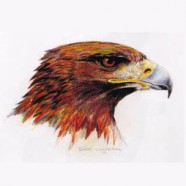
Selected Passages from the Final Report to Proyecto ARA A.C.
Introduction
Mexico’s national bird, the golden eagle (Aquila chrysaetos), is classified as “in danger” in Article 9 of the Federal Hunting Law (SEDUE 1984) and Ramos (1986) classifies the population as declining, primarily due to decreases in habitat quality. Environmental pollution (particularly pesticides), direct persecution, and illegal trade are all thought to play a part in the decline (Ramos 1986). Although some information exists about the natural history of golden eagles in the southwestern United States of America, very little is published about this species in the most southern reaches of its North American distribution. The long-term survival of the Mexican golden eagle population depends upon understanding its status, its biology, and details of its prey and habitat. A lack of data undermines conservation efforts for the golden eagle, as well as for plants and animals associated with it. For this reason, basic research must be conducted on the golden eagle in Mexico. New information will promote the conservation of this species, which is important both ecologically and culturally to the Mexican people, and the conservation of other, less high-profile species associated with the eagle and its habitat. This research also will add to the knowledge of this cosmopolitan, but difficult to study eagle.
Throughout their range, golden eagles typically prefer open habitats, especially in mountains / hills. If successful, they raise 1 brood per year. They especially prefer jackrabbits-sized prey, but will feed on other prey (even carrion) when food items of this size are scarce. They typically form long-term pair bonds that are based upon long-term occupancy of a single nesting territory by both pair members. In most of the western US, territories are occupied year-round.

A study of the golden eagle in Mexico
The purpose of this study was to increase understanding of the ecology of golden eagles in Mexico, so that an effective management plan could be developed to conserve them. The aims of the project focussed on describing movements of breeding golden eagles, and assessing the habitat upon which they depend. Movements of both breeding birds and non-breeding eagles were to be monitored throughout the year using radio telemetry via satellite. This information was of interest because little is known about the space/habitat requirements of breeding birds in Mexico, or of the requirements of non-breeding and wintering birds. Conventional telemetry was to provide localized data on behavior, diet, and habitat use. Also, it was a means of determining the fate of eagles whose PTTs had ceased operating properly.
Methods were chosen to compliment one another, and to draw on our own experience, the experience of other experts in the field, and published information. Some methods were chosen because they allowed us to better understand the ecology of Mexican eagles by being comparable to studies elsewhere in the world. Our methods utilized new technologies, which should have enabled us to collect unique data on golden eagle ecology.
It was understood from the beginning that because eagles are long-lived, the mileposts in their lifetime reproductive strategy can only be achieved after a number of years. For this reason, studies of eagles are better conducted over many years, and the achievements one can expect in a single year are limited to the more quickly assessed, short-term aspects of their natural history.
Abstract
From February1997 – January 1998 we studied golden eagle occupancy, breeding success and movements in north-central Mexico. Initial surveys of the study area were performed, and nest sites were monitored for occupancy and breeding success. Few occupied nests sites were productive in 1997. In those that were, 1-2 nestlings were produced per successful attempt. Also, it appeared that there was a high turnover of breeders that might be linked to direct persecution or incidental poisoning. An attempt was made to capture golden eagles for radio- marking. The focus was on breeders, but we were also interested in fledglings and other age classes. During this time we radio-marked 7 golden eagles from 5 nesting areas with 401 MHz satellite-received Platform Terminal Transmitters (PTTs) and conventional (164 MHz) tail-mounted transmitters. When used in combination the two transmitter technologies allowed us to ground track individuals for behavioral observations (using conventional transmitters), and obtain ranging information on individuals if they left the immediate area of the nest nesting area (using the PTTs). Substandard components in the PTTs prevented the acquisition of the volume of location estimates that we had anticipated. However, we were able to determine that the breeding eagles were resident on their territories. The PTT on one eagle (14506) worked as expected. Simple range analysis revealed that at the 80% level the location estimates encompassed 59,419 ha. At the 40% level, 6,975 ha. were encompassed.
Methods
We searched the literature for information on Mexican golden eagles. Very little work has been published on eagles in Mexico; some studies have been conducted in Texas and Arizona, but are not very recent. Juan Vargas held considerable unpublished knowledge of some pairs.
A protocol was devised for the first year’s study. This was finalized in March of 1997. The aims for 1997 focused on the collection of data that would illuminate habitat requirements of golden eagles in Mexico. As in any study of wildlife, the protocol was flexible, and emphases could be shifted to accommodate conditions in the field. The aims were changed and superceded by events in the field, although the overall objectives remained the same.
Initial surveys
Ara biologists performed early surveys of eagle areas. ARA/Earthspan biologists then conducted surveys for golden eagle occupancy in north-central Mexico in the states of Nueva Leon, San Luis Potosi, Zacatecas, and Aguascalientes during February – July. We investigated reported sightings of breeding eagles and historical nests as well as surveying likely cliffs for nests. Other suspected sites were investigated. Surveys relied heavily upon the Juan Vargas’ experience and knowledge of local eagle sites.
Capture and Marking
Priority was given to the capture of individuals that were nesting, at sites that were most easily accessible by road, and at sites that would provide the most advantageous monitoring situation (in terrain that was not extremely severe). We attempted to trap a maximum of 9 eagles beginning May 1997, using dho-gazas surrounding a lure golden eagle (see Bloom 1987) or radio-controlled bownet with a lagomorph as a lure for breeders (Jackman et al. 1994), and hand-capture in nests for nestlings. We placed traps in view of habitual perch locations or along regularly used flight paths. Trap placement was usually made the night before the attempt. We observed traps from blinds placed at least 100m away. Attempts were not made earlier in the season because we might have disrupted the breeding effort; trapping of breeding birds during the nesting season should not occur before the chicks are about two weeks old. At this age eaglets begin to be able to thermoregulate, and trapping activities are less likely to have a direct impact on them. Ideally we wanted to attempt eagle capture when nestlings were 2-7 weeks of age. After that time, breeding eagles spend less time at the nest, and are harder to capture. We targeted individuals in occupied and productive nesting areas.
We instrumented each captured eagle with an approximately 100g backpack package including an 85g PTT 100 (Microwave Telemetry) Platform Terminal Transmitter (PTT; 401 MHz) and a 15-20g harness, as well as a 12-15 g conventional, tail-mounted transmitter (VHF;164 MHz). PTTs were attached in a backpack configuration with 12.5mm TeflonÒ ribbon (Bally Ribbon Mills, Bally, PA, USA) secured with copper tubes, crimped around the TeflonÒ ribbon. Conventional transmitters were attached to a newer feather with superglue or epoxy, and thread. The criteria that must be met for eagles to be radiotagged were: 1) the eagle must weigh > 3000g (at which point the transmitter and PTT would weigh <3% of the eagle’s body mass); 2) the eagle must have no injury that might be exacerbated by carrying the transmitters; and 3) the eagle must have hard-penned feathers to accommodate a tail-mounted transmitter. The field team was authorized to release any eagle for any reason if they thought the fitting of a transmitter might reduce the eagle’s survivability.
All eagles captured were measured and, where possible, sexed and aged. We took the following morphological measurements: mass (kg), beak depth (mm), culmen length (mm), hallux length (mm), wing chord (curved; cm), wing span (cm), and tail length (cm). Measurements will provide data on eagle flight biomechanics for a cooperative study with Prof. C. Pennycuick, Bristol University, UK. We drew approximately 3 ml of blood from some captured eagles. Each captured eagle was banded with a USFWS numbered band for individual identification.
Throughout the capture, measuring, and transmitter fitting process, all efforts were made to reduce the stress on the eagle. The field team had the authority to release any eagle thought to be unduly stressed.
